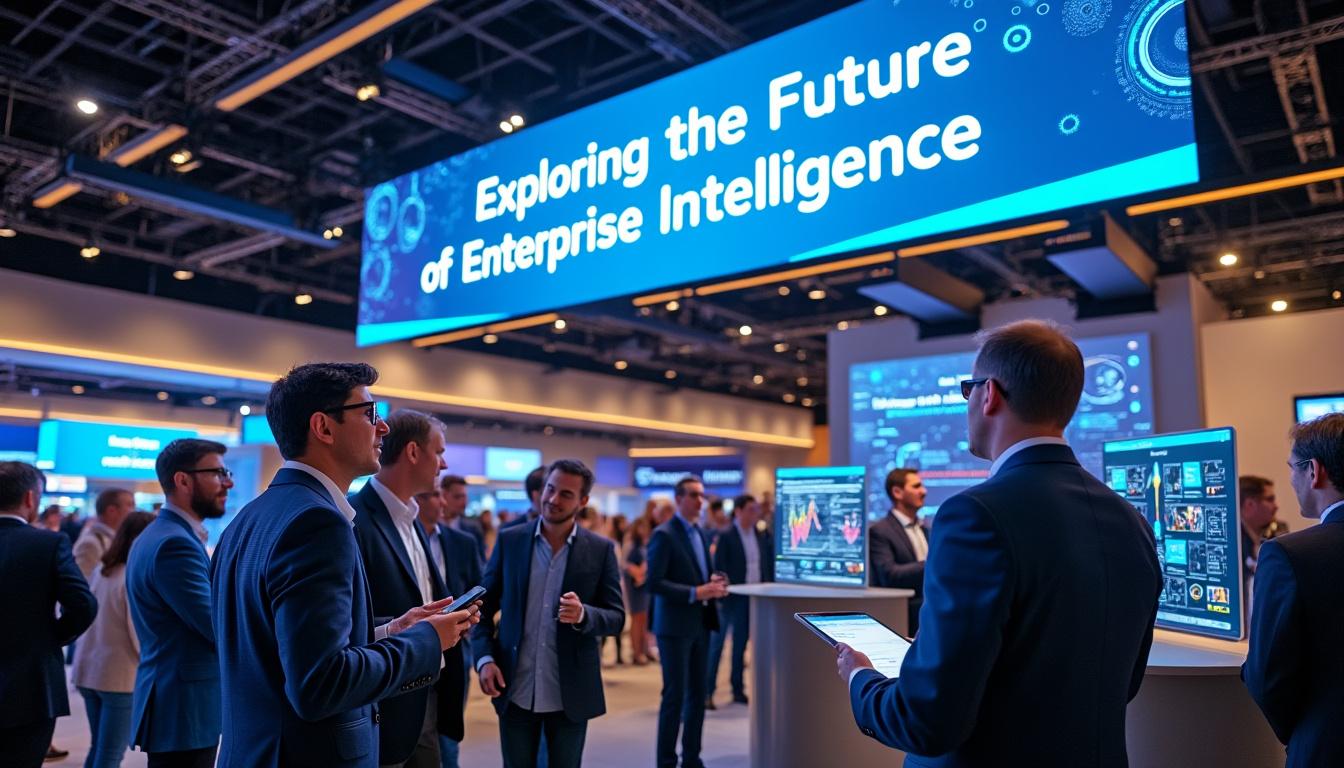The Databricks Data + AI Summit 2025 demonstrated a pivotal evolution in enterprise intelligence, driven by advancements in AI, cloud computing, and integrated data architectures. Organizations are now leveraging AI not only to gain faster insights but to transform governance, enhance accessibility, and embed real-time analytics into business-critical workflows. This year’s summit underscored how unified platforms and automated tools are reshaping the landscape of big data and machine learning, enabling enterprises to operationalize AI at scale with robust oversight.
Advancements in Agentic AI and Its Role in Enterprise Intelligence
Agentic AI technologies are rapidly maturing beyond experimental phases, becoming integral to operational environments. Databricks’ introduction of Agent Bricks at the AI Summit enables the creation of domain-specific AI agents equipped with built-in evaluation and fallback mechanisms, alongside human-in-the-loop oversight. This development addresses critical issues of trust and governance, which serve as foundational requirements for enterprise adoption.
- Human oversight remains essential for mitigating operational risks.
- Trust is the differentiating factor between successful scaling and failed deployments.
- Agent Bricks provides a UI-driven workflow to streamline agent creation and monitoring.
- Fallback logic embeds resilience in AI applications, enhancing reliability.
These elements demonstrate the importance of integrating automated insights with stringent governance frameworks to ensure AI operates safely and effectively within enterprise systems. This progression extends discussions found in cybersecurity and AI trust paradigms, highlighting parallels with findings on managing risk in agentic AI.
Trusted AI Frameworks Enhancing Operational Workflows
Successful deployment of agentic AI requires an architectural emphasis on governance and compliance. Tools like Databricks Unity Catalog empower enterprises to manage access rights, lineage, and security policies seamlessly across data, ML models, and AI endpoints. This integration is essential to maintain operational integrity while transitioning AI agents from pilots to mission-critical systems.
| Feature | Enterprise Benefit | Impact on AI Adoption |
|---|---|---|
| Human-in-the-loop Review | Reduces risk of erroneous outputs | Increases stakeholder confidence |
| Fallback Logic | Enhances fault tolerance | Improves system reliability |
| Built-in Evaluation | Monitors agent performance continuously | Supports scalable operations |
| Unified Governance via Unity Catalog | Centralizes control over data and models | Streamlines compliance and auditability |
Platform Unification as a Competitive Edge in Big Data and Cloud Computing
Databricks is pioneering a shift from fragmented architectures to unified AI-native platforms that merge online transactional processing (OLTP) and analytical processing (OLAP) within a single foundation. This convergence facilitates real-time data analytics and machine learning operations without the latency or complexity traditionally associated with separate systems.
- Lakebase introduces a Postgres-compatible transactional database optimized for real-time workloads.
- Lakeflow Designer offers a natural language, drag-and-drop interface for simplified ETL pipeline construction.
- MLflow 3.0 integrates experiment tracking with observability and governance across the AI lifecycle.
- Databricks Apps enable rapid development of generative AI applications using familiar programming languages with serverless architecture.
This architectural unification supports dynamic collaboration tools and business intelligence solutions by breaking down data silos and enabling seamless interaction between data ingestion, transformation, and machine learning processes. Organizations aiming to modernize their data infrastructure can find useful insights on migration and modernization challenges in related discussions on no-code approaches for AI adoption and manufacturing data analytics.
Streamlining Real-Time Analytics and AI Deployment
Integration of transactional and analytical engines enables AI agents to interact directly with live business data, eliminating latency challenges and improving decision-making speed. The resulting platform accelerates time-to-insights and delivers automated insights critical for competitive market positioning.
| Component | Role in Platform | Value to Enterprise |
|---|---|---|
| Lakebase | Transactional data storage with Postgres compatibility | Facilitates real-time application updates |
| Lakeflow Designer | ETL pipeline creation with natural language interface | Simplifies data transformation tasks |
| MLflow 3.0 | Unified model lifecycle management | Improves governance and reproducibility |
| Databricks Apps | Serverless AI application development | Accelerates operational deployment |
Democratization of AI Through Unified User Experiences
The availability of AI-enabled platforms to a broader range of users is rapidly advancing. Databricks One introduces a unified experience that enables business analysts and non-engineers to use natural language queries to explore enterprise data, reducing dependency on specialized technical teams.
- Expands access beyond engineers to business analysts and decision-makers.
- Enhances collaboration by breaking down data silos.
- Accelerates insight generation through intuitive interfaces.
- Supports enterprise data strategies by widening platform use cases.
Such democratization is a key driver for AI growth and is closely linked with ongoing discussions about business AI growth insights and AI-enhanced enterprise intelligence available through platforms like business AI growth strategies and SAP AI integration.
Enabling Broader Workforce Participation in Data Analytics
By providing a natural language interface, Databricks reduces the technical barrier for data analysis and improves collaboration across departments, allowing organizations to harness collective intelligence and drive strategic outcomes effectively.
| User Type | Capabilities Enabled | Impact on Enterprise |
|---|---|---|
| Business Analysts | Natural language queries and explorations | Faster, data-driven decision making |
| Data Scientists | Advanced model development and pipeline tracking | Enhanced model quality and governance |
| IT Teams | Unified governance and access control | Improved compliance adherence |
| Executives | Overview dashboards with automated insights | Strategic oversight and agility |
Vertical Integration Versus Ecosystem Fragmentation in Enterprise AI Platforms
The trend towards vertical integration is gaining traction as enterprises demand seamless data ingestion, governance, modeling, and deployment within a single ecosystem. Unlike competitors that offer modular AI services often fragmented across different tools, Databricks delivers a comprehensive platform with unified lifecycle management.
- Unity Catalog enforces rigorous access and security policies.
- Support for Apache Iceberg fortifies governance over diverse data sets.
- Full-stack capabilities eliminate the need for extensive third-party integrations.
- Vertically integrated platforms reduce latency and improve data consistency.
When compared with offerings such as Snowflake’s Arctic and Google’s Gemini agents, Databricks’ strategy emphasizes open architecture combined with unified governance, creating a scalable foundation for enterprise intelligence that aligns with evolving market demands. Insights on AI agent markets and multi-agent orchestration highlight the criticality of integration for reliability in this space and can be explored further at agentic AI market growth analysis and multi-agent orchestration studies.
Comparative Analysis of Leading Enterprise AI Platforms
| Platform | Integration Level | Governance Model | AI Capabilities | Notes |
|---|---|---|---|---|
| Databricks | Full vertical integration | Unity Catalog with Apache Iceberg support | Agentic AI, MLflow 3.0, Generative AI Apps | Open architecture, unified governance |
| Snowflake | Modular with integrations | Separate governance tools | Cortex AI services, Arctic LLM | Requires multiple service coordination |
| Google Cloud | Partial integration | Governance via separate products | Gemini Agents, BigQuery AI | Embedded AI but fragmented governance |
| Microsoft | Modular expansion | Diverse governance solutions | Copilot across Power BI & Office | Integrated but with ecosystem dependencies |
Streamlining Migration and Modernization with AI-Powered Tools
Migration to modern enterprise data platforms frequently faces barriers related to complexity, cost, and risk. Databricks’ Lakebridge, an AI-driven migration assistant offered at no charge, automates key processes such as schema translation, optimization, and validation, easing the transition from legacy systems.
- Automates intricate migration tasks to reduce manual errors.
- Supports both data warehouses and lakehouse modernization.
- Decreases operational risks while improving predictability.
- Accelerates modernization timelines with automated workflows.
These enhancements are crucial for enterprises seeking a turnkey path to upgrade without project overruns. Organizations can deepen their understanding of migration strategies and economic impacts by referencing analyses on blockchain advancements and AI-driven operational intelligence found at economic implications of blockchain and business AI growth insights.
Key Benefits of AI-Assisted Migration Tools
| Functionality | Benefit | Enterprise Impact |
|---|---|---|
| Schema Translation | Converts legacy schemas automatically | Reduces manual labor and errors |
| Data Optimization | Enhances query performance on new platforms | Improves operational efficiency |
| Data Validation | Ensures data integrity post-migration | Maintains compliance and accuracy |
| Cost Reduction | Automates complex steps to save budget | Enables faster ROI on modernization |


